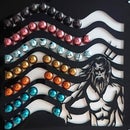Introduction: Lasercut Stormtrooper
Wall art has always been one of those things that I wanted to try my hand at, lingering in the back of my head but never coming to fruition out of fear that I might ruin said wall. As an intermediate step I figured out a way to do all the drawing and coloring a safe distance away: Mosaic tiles!
And what better way to make a mosaic than by lasercutting a stormtrooper out of some cheap MDF? Materials you'll need:
- 60x60 cm of pre-painted MDF, I used 3mm but any thickness you have laying around works fine.
- Sticky Putty or Blu Tack, those pasty things meant to temporarily fix posters to the wall.
- Some acrylic paints and brushes
- A lasercutter
Step 1: Preparing the File
First of all you want to draw something cool or find some image to base your mosaic on. We'll then open this image in Inkscape and trace lines over it to divide it into polygons that our laser can recognize (SHIFT-F6). To make this a little easier I googled for existing Low-poly artwork and settled on one of the amazing drawings by Justin Maller. Especially knowing what color to give your polygons can be a daunting task if you base yourself on a movie poster or so.
In some cases it may be possible to have Inkscape do the work by using the "Trace bitmap" command under "Paths". If your base art is not colored and has clearly defined lines this might work well, an example would be an image from a coloring book like the BB8 droid picture above. In the other case it just comes out messed up so you might as well trace it yourself. Once that is done you end up with a cuttable vector image like the red one above, but before you can get to the actual cutting there are two more important steps:
- Clean up: Zoom out and try to imagine the drawing on your wall. You'll find that many of the triangles you drew are too small to be visible; these will only make your life difficult later on. Go ahead and delete those, re-arranging points (F2) and creating larger tiles as you go.
- To add depth to the end result you may want to leave some spacing between the tiles. I thought 2 mm of spacing would work well so I set the line width to 2mm, took a screenshot, imported the screenshot back into Inkscape, and used the Trace Bitmap command. Make sure the settings for bitmap tracing are not set to round corners, sharp corners look better. Now set line color to black and line fill to nothing, and the result will be a drawing like the black one above.
- Having some spacing not only looks good, but will also make painting significantly easier.
Step 2: Lasercutting the Tiles
Now that you have a good-looking vector file (or have downloaded mine), you can get to cutting.
Using pre-painted white MDF will make your job a LOT easier later on. Untreated MDF soaks up water like crazy and it's nigh impossible to paint it. Alternatively you could use real wood and primer it or leave it unpainted. Another advantage is that burn marks from the laser can be wiped off with a damp cloth, which is not really the case for untreated MDF.
Place the painted side downward on a honey-grate pattern or similar and activate the laser. After cutting, use some painter's tape to fix all the pieces in place before taking it out of the machine. You want to keep it together at all times - good for your emotional stability ;)
Attachments
Step 3: Painting!
Painting the tiles is pretty straightforward: use several thin layers for the best effect, or a single thicker layer if you're lazy like me. You'll likely only notice the difference when looking at it from close by anyway.
If you decided to go without spacing, you'll have to either take out the tiles one by one or be very, very careful at this point. Fair warning: there will be more tiles than you thought. Patience is a virtue!
Step 4: Stick It to a Wall
After the paint is dry, turn it over on a plate of MDF and remove the painter's tape. Add one or more little balls of sticky putty to each tile. Especially for the long and thin ones it's useful to add more than one ball of putty.
Then just smack the whole thing onto a wall, almost finished! Ask someone to hold it while you fix the whole plate to the wall with some tape. Now press-wiggle every individual tile into the wall, to make sure they all stick. Even if you laser cut through all the tiles 100% successfully, tiles will stick to the frame where some paint went over the lines. Now slowly remove the frame; if this is difficult it might be handy to have some clippers ready so you can take off the frame in parts.
Side note: Depending on the type of paint on your wall, the sticky putty will leave greasy marks if you leave it up for too long. I placed mine on a door because it has a glossy varnish finish, and the putty does not leave any marks on it.
That's it! Enjoy your all-new totally risk-free wall art!

Participated in the
Home Decor Contest














